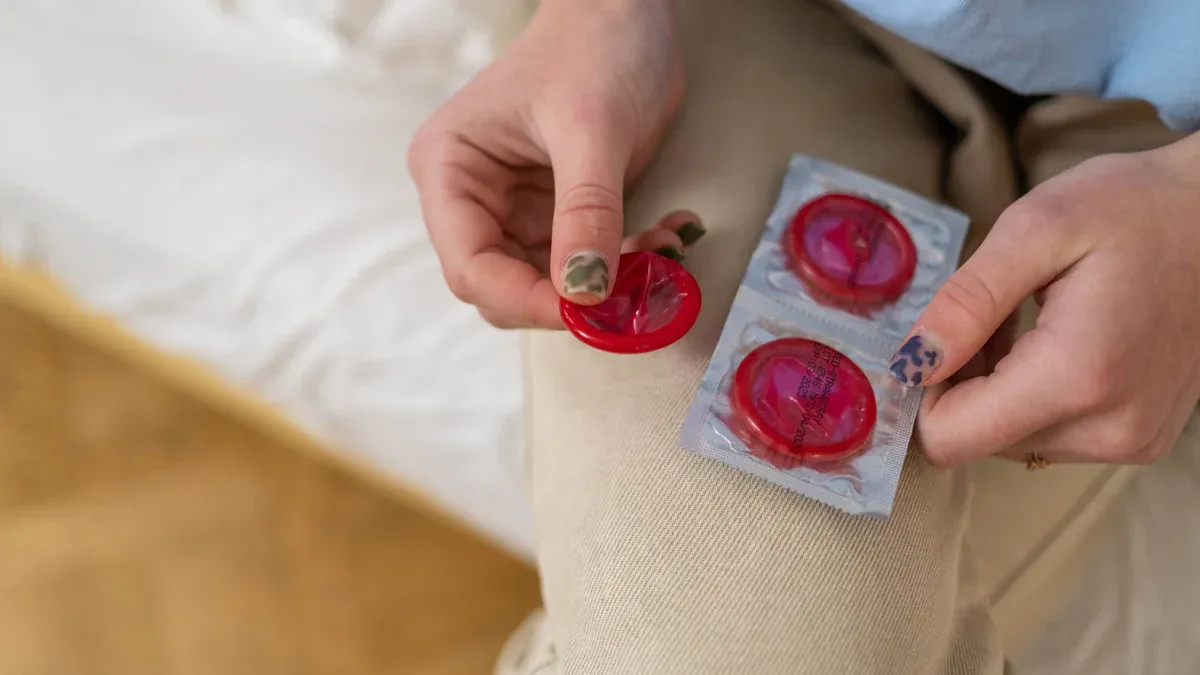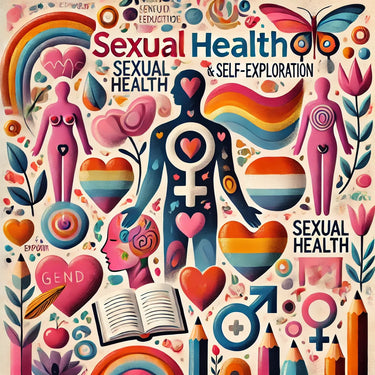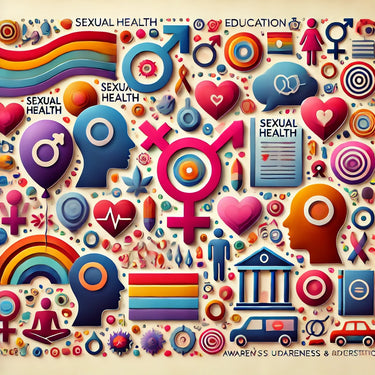Debunking Misconceptions About Sexually Transmitted Infections in 2025

You might think that by 2025, everyone is aware of the truth about sexual health. However, common myths about sexually transmitted infections (STIs) still spread rapidly. These common myths about sexually transmitted infections can cause significant harm. They make people feel embarrassed, deter them from seeking help, and can even lead to serious health complications. According to the World Health Organization, over one million people aged 15 to 49 contract a curable sexually transmitted infection every day. Consider how many individuals face this issue each year:

If you believe these common myths about sexually transmitted infections, you might avoid discussing sexual health or delay getting tested. This can result in more infections and increased stigma. To stay safe and support others, it is essential to know the facts and put an end to these outdated misconceptions.
Key Takeaways
Anyone who has sex can get an STI. It does not matter how old you are. Your background does not matter either. This is why everyone should get tested often.
Most STIs do not have any signs. You cannot tell if you have one by how you feel. You also cannot tell by how you look.
STIs do not spread by touching things like toilet seats. They do not spread by sharing forks or hugging. They spread through certain activities with body fluids.
Using condoms every time you have sex helps a lot. It lowers the chance of getting or giving STIs. Condoms help keep your sexual health safe.
Talking openly about sexual health is important. It helps people get tested and treated. This helps everyone stay safe and healthy.
Common Myths About Sexually Transmitted Infections (STIs)
You might think you know the truth about STIs, but many common myths about sexually transmitted infections (stis) still confuse people. These myths can make you feel worried, stop you from getting tested, or even put your health at risk. Let’s break down the most common misunderstandings and see what the facts really are.
Myths and Facts
You probably hear a lot of stories about STIs. Some people say only certain groups get them. Others believe you can spot an infection just by looking. These are not true. Anyone who is sexually active can get an STI, no matter their age, gender, or background. You cannot always tell if someone has an infection. Many people with an std do not show any signs at all.
Note: You cannot rely on how someone looks or acts to know if they have an STI. Regular testing is the only way to be sure about your sexual health.
Let’s look at a few myths and facts in a simple table:
Myth |
Fact |
|---|---|
Only “promiscuous” people get STIs |
Anyone who is sexually active can get an STI |
You can tell if someone has an STI by looking |
Most STIs have no visible symptoms |
STIs are rare in older adults |
People of all ages can get STIs, including those over 50 |
You can get an STI from a toilet seat |
STIs do not spread through toilet seats or casual contact |
Transmission Myths
You might worry about catching an std from a toilet seat or sharing a drink. This is one of the most common myths about sexually transmitted infections (stis). In reality, STIs do not spread through casual contact, hugging, or sharing utensils. You only get them through specific activities, like unprotected sex or sharing needles.
Recent research shows that many people still do not understand how HIV spreads. Some think you can get HIV from closed-mouth kissing or touching. This is not true. HIV passes through blood, semen, vaginal and rectal fluids, and breast milk. It does not pass through saliva, sweat, or tears. If someone with HIV has an undetectable viral load, they cannot pass the virus to their partner during sex. This is called Undetectable = Untransmittable (U=U), but many people do not know this yet.
Here are some common myths about transmission:
You can get an STI from a toilet seat or swimming pool.
Sharing food or drinks spreads STIs.
Only certain groups, like men who have sex with men, get HIV.
Closed-mouth kissing can give you HIV.
None of these are true. You can protect your sexual health by knowing the real risks and using condoms or other barrier methods.
Symptom Myths
You might think you will always know if you have an std. This is another one of the common myths about sexually transmitted infections (stis). Many STIs do not cause any symptoms at all. You can feel fine and still have an infection. For example, chlamydia often has no signs, but it can still harm your body if you do not treat it.
Some people believe that if they do not see sores or feel pain, they must be healthy. This is not true. You can have an STI and not know it. That is why regular testing is so important for everyone who is sexually active.
Tip: Do not wait for symptoms. Make regular STI checks part of your sexual health routine.
You can see that myths and facts about STIs are not always clear. By learning the truth, you can protect yourself and others. You can also help stop the spread of stigma and shame around sexual health.
Transmission Myths

Difficult to Get HIV from Casual Contact
You might have heard that it is difficult to get HIV from casual contact. This idea still confuses many people. You cannot contract HIV by shaking hands, hugging, or sitting next to someone. HIV does not spread through the air or by touching objects. The virus needs certain body fluids to move from one person to another. These fluids include blood, semen, vaginal fluids, and breast milk. You only face a real risk of HIV transmission when these fluids enter your body, usually during unprotected sexual intercourse, sharing needles, or from mother to baby during birth or breastfeeding.
You may wonder about the ways HIV cannot be transmitted. You cannot get HIV from sharing a toilet seat, using the same utensils, or drinking from the same cup. Even if you kiss someone on the cheek or share a towel, you stay safe. The risk of HIV transmission does not exist in these situations. You only need to think about protection during activities that involve direct contact with body fluids.
Some people worry about saliva, sweat, or tears. These fluids do not carry enough virus to transmit HIV. Closed-mouth kissing, sharing food, or touching do not put you at risk. If you use PrEP, a daily pill, you can lower your risk of HIV transmission even more. PrEP works best when you take it as prescribed and combine it with other safe practices.
Tip: You can protect your sexual health by learning the facts. You do not need to fear casual contact with someone who has HIV.
Not Spread by Toilet Seats or Utensils
Many people still believe you can get an STD from a toilet seat or by sharing utensils. This myth causes a lot of worry, but it is not true. Medical experts explain that sexually transmitted infections need direct sexual contact to spread. You cannot contract HIV or any other STI by sitting on a toilet seat or using someone else’s fork. The germs that cause these infections do not survive on hard surfaces for long. They also do not pass from one person to another through casual contact.
Urinary tract infections and yeast infections also do not spread this way. UTIs happen when bacteria from your own body enter your urinary tract. Yeast infections come from an overgrowth of fungi that already live on your skin. You do not catch these from toilets or shared drinks. If you focus on real risks, you can keep your sexual health strong and avoid unnecessary fear.
Note: You only need to worry about STIs when you have direct sexual contact or share needles. Everyday activities like using public toilets or eating with friends do not put you at risk.
Anyone Can Get an STI
You might think only certain people get STIs. This is not true. Anyone can get HIV or another STD, no matter their age, gender, or background. Demographic data from around the world show that sexually transmitted infections affect people of all ages. Even older adults face rising rates of STIs. In some countries, people over 60 have seen a big increase in infections like syphilis and gonorrhoea. Many factors play a role, such as continued sexual activity, low condom use, and social stigma.
You cannot tell who has an STD just by looking. You also cannot assume that only young people or certain groups need to worry. Anyone can get HIV if they have unprotected sex or share needles. If you use PrEP, you can lower your risk, but you still need to get tested regularly. Open conversations about sexual health help everyone stay safe.
Myth |
Fact |
|---|---|
Only certain people get STIs |
Anyone can get HIV or another STD |
Older adults do not need to worry |
STIs affect people of all ages, including those over 60 |
You can spot someone with an STI |
Most STIs have no visible symptoms |
Callout: You can protect yourself and others by learning the facts and getting regular check-ups. Sexual health matters for everyone.
Symptom and Prevention Myths
Most STIs Have No Symptoms
You might think you'll know you have HIV because of your symptoms, but this is not true for most people. Many STIs, including HIV and other common stds, can hide in your body without any signs. You can feel healthy and still have an infection. This is why so many people pass on stis without realising it. Some infections, like chlamydia or gonorrhoea, often show no symptoms at all. You cannot rely on how you feel to judge your sexual health. If you wait for symptoms, you might miss the chance to get early treatment and protect your partners.
Tip: Make regular check-ups part of your routine. You cannot always see or feel an std.
Condoms and Safe Sex
You might hear people say condoms do not work or that you do not need them if you trust your partner. This is a myth. Condoms are one of the best ways to prevent contracting HIV and other stis. They help prevent hiv transmission and also stop you from getting or passing on other stds like syphilis, herpes, and HPV. Studies from around the world show that condoms have helped millions of people avoid infections. Even with some risks, like breakage, condoms remain a key part of safe sex. When you use condoms every time, you protect your sexual health and your partner’s too.
A lot of young people know that condoms help prevent transmitting hiv. They also understand that using condoms can stop unwanted pregnancies. If you talk openly with your partner and feel confident about using condoms, you both stay safer. Remember, condoms are not just for new relationships. They matter in long-term ones as well.
Regular Screening Is Essential
You cannot see most stis, so regular screening is essential. Health experts recommend that you get tested even if you feel fine. Many infections, like chlamydia and gonorrhoea, often hide in places you cannot check yourself, such as the throat or rectum. The World Health Organization says regular screening helps find these hidden infections and keeps you and your community healthy. Screening also helps stop the spread of stds and fights drug resistance, which makes some infections harder to treat.
Screening targets infections that do not show symptoms, especially in women.
It helps health services reach the goal of cutting down new cases by 90% before 2030.
Early testing means you can get treatment quickly and avoid passing on infections.
Screening is important for everyone, not just people with many partners.
Callout: You can take charge of your sexual health by using condoms and getting regular tests. This keeps you and your partners safe from stis and stds.
HIV and Treatment Myths
Having HIV Means You Have AIDS
You might hear people say that having HIV means you have AIDS. This is not true. HIV and AIDS are not the same thing. HIV is a virus that attacks your immune system. AIDS is a group of illnesses that happen when HIV has weakened your immune system a lot. You can live with HIV for many years without getting AIDS, especially if you take your medicine every day.
Here’s a simple table to help you see the difference:
Aspect |
HIV (Human Immunodeficiency Virus) |
AIDS (Acquired Immunodeficiency Syndrome) |
|---|---|---|
Nature |
Virus that infects and multiplies inside immune cells |
Syndrome caused by severe immune system damage from HIV |
Target |
Attacks helper T cells in the immune system |
Diagnosed when T cell count falls below 200 cells/µL blood |
Disease Progression |
Can stay dormant for years |
Happens after immune system collapses |
Symptoms |
Often no symptoms for a long time |
Many infections and illnesses appear |
Diagnosis Criterion |
Presence of virus in the body |
T cell count < 200 cells/µL plus related symptoms |
Treatment |
Antiretroviral therapy can control the virus |
No cure; treatment manages symptoms and infections |
You might worry that you have just a few years to live if you get HIV. This is not true anymore. With modern treatment, you can live a long and healthy life. You can have a healthy baby if you are HIV-positive. Doctors can help you lower the risk of passing HIV to your child.
HIV Can Be Cured
Many people ask if HIV can be cured. Right now, there is no cure for HIV. Scientists are working hard to find one, but it is not here yet. Antiretroviral therapy (ART) can control HIV and stop it from damaging your immune system. ART does not remove the virus from your body, but it keeps you healthy and stops you from passing HIV to others.
ART stops HIV from multiplying, but some virus hides in your body.
New treatments are being tested, like special antibodies and T cell therapies.
Some studies use new ways to wake up hidden virus and try to remove it.
Most research focuses on making treatments safe and easy for everyone.
If you take your medicine every day, you can live a normal life. Sex is safe when both partners have HIV, but you still need to protect yourself. You can’t avoid other HIV-related infections if your immune system gets weak, so regular check-ups matter.
No Home Remedies for STIs
You might hear about home remedies for STIs, like garlic, tea tree oil, or herbal teas. Some people say these can cure infections. The truth is, there is no home remedy that can cure an STI. Some natural products, like Aloe vera or Goldenseal, show promise in the lab, but doctors do not recommend them as a main treatment. You need proper medicine from a healthcare provider to treat STIs.
For example, antibiotics work well for many bacterial STIs, but you need the right dose and type. If you try to treat an STI at home, you might not get better. You could even make the infection worse or help it spread. Always talk to a doctor if you think you have an STI. Home remedies might help with symptoms, but they do not cure the infection.
Tip: Trust your doctor and use proven treatments. Home remedies are not a safe replacement for real medicine.
Stigma and Social Myths

Only Certain People Get STIs
Some people say only certain people get STIs. This is not true at all. Anyone who is sexually active can get an STI. It does not matter how old you are or your background. Every year, millions of people from all groups get new cases. You do not have to fit a certain type to be at risk. Learning about sexual health helps everyone, not just a few people. If you believe this myth, you might skip testing or feel too shy to ask questions. This can put your health in danger and make it harder for others to speak up.
Tip: Remember, STIs can affect anyone. You can stay safe by learning the facts and getting regular check-ups.
Menopause and STI Risk
Some people think they do not need to worry about STIs after menopause. This is not true. Studies show women aged 41–55, including those after menopause, still have a high risk of infections like HPV. Changes in your body, like less oestrogen and fewer good bacteria, make infections easier to get. Your body’s defences change, and the vagina cannot fight germs as well. Doctors found that poor vaginal cleanliness and higher pH levels are more common in post-menopausal women with infections.
Women aged 41–55 often have high-risk HPV infections.
Less oestrogen and fewer good bacteria raise the risk.
Changes in vaginal pH and cleanliness make infections more likely.
Note: No matter your age, regular STI checks are important for your health.
Stigma and Misinformation
Stigma and wrong ideas can make you feel alone or scared to get help. You might worry about what others think or fear being judged. This can stop you from getting tested or treated. Research shows stigma causes more sadness, worry, and loneliness. It also makes it harder to keep up with treatment or talk about your health. People in the countryside and women often feel more worried about what others might say. Stigma does not go away just because you know the facts. It can hurt your feelings and your friendships.
Aspect |
Findings |
|---|---|
Knowledge Levels |
Most people know about HIV, but stigma is still high |
Stigma Domains |
People worry most about telling others and what the public thinks |
Impact of Stigma |
Stigma hurts mental health and stops people from getting help |
Gender and Rural Differences |
Women and people in the countryside feel more stigma |
Implications |
Stigma and wrong ideas keep people from getting tested or treated |
You can help break this cycle. Support from friends and honest talks make a big difference. Campaigns that use peer support, clear facts, and kindness work best. When you talk openly and challenge myths, you help others feel safe to do the same.
You now know that myths like the “Blue Waffle Disease” are just internet hoaxes, while real STIs such as herpes and HIV need proper attention. Regular testing helps you catch infections early, even when you feel fine. Open chats with partners and doctors make a big difference. If you want reliable advice, check out Everyday Health or Verywell Health. Let’s keep talking, support each other, and make sexual health a normal part of life.
FAQ
Can you get an STI from oral sex?
Yes, you can. Oral sex can pass on infections like herpes, gonorrhoea, and chlamydia. Using condoms or dental dams helps lower your risk. Regular testing keeps you safe.
How often should you get tested for STIs?
If you are sexually active, you should get tested at least once a year. If you have new partners or notice symptoms, test more often. Regular checks help you stay healthy.
Do you need to tell your partner if you have an STI?
Yes, you should. Telling your partner helps protect their health and builds trust. Most people appreciate honesty. Your doctor can give you advice on how to talk about it.
Can you get an STI more than once?
You can get the same STI again, even after treatment. Your body does not always build lasting protection. Using condoms and regular testing helps prevent new infections.
Are home STI test kits reliable?
Most home test kits work well if you follow the instructions. Some tests need a doctor’s visit for full results. If you get a positive result, see your doctor for advice and treatment.








